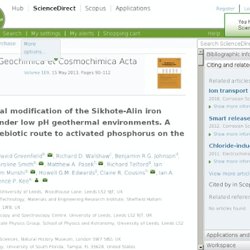

The source of first life on Earth discovered. Life's first energy source discovered. ATP is sometimes compared to a "rechargeable battery," as it stores chemical energy that can be used by organic matter.

Terence Kee is a researcher at the University of Leeds in England. As he told LiveScience, "You need enzymes to make ATP, and you need ATP to make enzymes. The question is: Where did energy come from before either of these two things existed? We think that the answer may lie in simple molecules, such as pyrophosphate, which is chemically very similar to ATP, but has the potential to transfer energy without enzymes. " Previously, scientists thought that life emerging from “mere chemistry” came from a similar compound called pyrophosphate. The fact that pyrophosphite is so rare on modern Earth does not worry scientists, as it is considered highly unstable in today's oxygen-rich environment.
For further reading: Power behind primordial soup discovered. While it is generally accepted that some important ingredients for life came from meteorites bombarding the early Earth, scientists have not been able to explain how that inanimate rock transformed into the building blocks of life.

This new study shows how a chemical, similar to one now found in all living cells and vital for generating the energy that makes something alive, could have been created when meteorites containing phosphorus minerals landed in hot, acidic pools of liquids around volcanoes, which were likely to have been common across the early Earth.
“The mystery of how living organisms sprung out of lifeless rock has long puzzled scientists, but we think that the unusual phosphorus chemicals we found could be a precursor to the batteries that now power all life on Earth. In their analysis of the resulting solution the scientists found the compound pyrophosphite, a molecular ‘cousin’ of pyrophosphate – the part of ATP responsible for energy transfer. Did phosphorous from space spark life on Earth? U.

LEEDS (UK) — Experiments suggest that unusual phosphorus chemicals from meteorites could have given power to Earth’s “primordial soup.” While it is generally accepted that some important ingredients for life came from meteorites bombarding the early Earth, scientists have not been able to explain how that inanimate rock transformed into the building blocks of life. “If Curiosity has found phosphorus in one of the forms we produced in Iceland, this may indicate that conditions on Mars were at one point suitable for the development of life in much the same way we now believe it developed on Earth,” says Terry Kee. (Credit: ©James McKay 2013) This new study shows how a chemical, similar to one now found in all living cells and vital for generating the energy that makes something alive, could have been created when meteorites containing phosphorus minerals landed in hot, acidic pools of liquids around volcanoes, which were likely to have been common across the early Earth.
Meteorites could have been source of life's batteries - life - 04 April 2013. Geochimica et Cosmochimica Acta - Hydrothermal modification of the Sikhote-Alin iron meteorite under low pH geothermal environments. A plausibly prebiotic route to activated phosphorus on the early Earth. 1.

Introduction 2. Materials, location and experimental methods 3. Results and discussion 4. Acknowledgements Appendix A. References Abstract The Sikhote-Alin (SA) meteorite is an example of a type IIAB octahedrite iron meteorite with ca. 0.5 wt% phosphorus (P) content principally in the form of the siderophilic mineral schreibersite (Fe,Ni) 3 P. , Pi(III) as determined by 31 P NMR spectroscopy]. , PPi(III)] by dry-heating under mild (85 °C) conditions. , PPi(V)]. Copyright © 2013 Elsevier Ltd. How objects from space could have kindled life on Earth.
While it is generally accepted that some important ingredients for life came from meteorites bombarding the early Earth, scientists have not been able to explain how that lifeless rock transformed into the building blocks of life.

Now, a new study by researchers at the University of Leeds has shed light on the puzzle. Rock from space may have kick-started "chemistry" of Earth life. Power behind primordial soup discovered. Public release date: 4-Apr-2013 [ Print | E-mail Share ] [ Close Window ] Contact: Richard Mellorr.d.mellor@leeds.ac.uk 44-011-334-34031University of Leeds Researchers at the University of Leeds may have solved a key puzzle about how objects from space could have kindled life on Earth.

While it is generally accepted that some important ingredients for life came from meteorites bombarding the early Earth, scientists have not been able to explain how that inanimate rock transformed into the building blocks of life. This new study shows how a chemical, similar to one now found in all living cells and vital for generating the energy that makes something alive, could have been created when meteorites containing phosphorus minerals landed in hot, acidic pools of liquids around volcanoes, which were likely to have been common across the early Earth.
"Chemical life would have been the intermediary step between inorganic rock and the very first living biological cell. For more information 1. 2. 3. 4. Research: School of Chemistry, University of Leeds. People: School of Chemistry, University of Leeds. Research interests Phospho-Transfer Chemistry The primary interest in our laboratory concerns the role of phosphorus (P) in abiogenesis, the origins of life on earth.

Phosphorus is central to contemporary biochemistry (e.g. in DNA, RNA, cell membranes, ATP) but significant problems remain as to how Nature could have incorporated P into the earliest forms of life on earth.